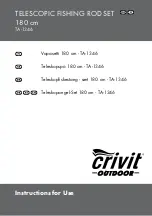
GSI Novus™ Newborn Hearing Screening System User Manual
D-0113050 Rev H
Page 80 of 96
TEOAE
S
TIMULUS
The IEC 60645-6 standard allows the use of manufacturer specific stimuli waveform
shapes. However, the current 60645-6 standard refers to the IEC60645-3 standard on
the specific topic of a reference stimulus characteristic for TEOAE measurements (i.e.
the use of short duration stimuli).
The IEC 60645-3 standard documents the electrical characteristics of a reference short
duration stimulus which is a rectangular, unipolar signal of 100 microsecond duration
(with a tolerance of 10 microseconds, and specified rise and fall times). Note that this
reference pulse is an ‘electrical signal’ that is used to generate an acoustic stimuli and as
such is heavily modified by the electro-acoustic nature of the probe transducer, the
acoustic design of the probe, and the ear simulator or other cavity that it used during
acoustic calibration of the equipment.
The GSI Novus utilises an optimised TEOAE stimulus that avoids the inherent difficulties
that arise during TEOAE measurements when using a simple unipolar rectangular pulse
such as the 60645-3 specified reference pulse. This optimised stimulus is bipolar so that
it contains no DC component. DC and low frequency energy (i.e. below 400Hz or so)
increase the risk of contamination of the TEOAE response with residual stimulus energy
– this typically occurs up to 4mS after the electrical pulse is applied. It is possible to
reduce this risk of contamination by only measuring the TEOAE response after say 5mS
has elapsed. However, the high frequency components of the TEOAE (which originate at
the basal end of the cochlea) will then be considerably diminished and the test will take
longer and be less effective. Furthermore, the optimised stimulus concentrates the
energy of the pulse in the frequency region that is most relevant to infant hearing
screening.
In order to permit comparisons of electrical calibration between the GSI Novus and the
IEC 60645-3 reference stimulus, this document provides a comparison of the energy
contained within the electrical characteristics of both the reference and the optimised
stimulus. This was calculated using an ‘area under the curve’ method, in other words a
simple integral of voltage over time for each of the stimuli shapes. Please note that a
pure rectangular electrical pulse is rarely measurable at any accessible point on OAE
equipment since there will usually be filtering applied to the signal once it has been
generated by the DAC long before it reaches the OAE probe. Fast edged signals contain
considerable high frequency energy and cause problems with no benefits at all in OAE
measurements. Furthermore, sometimes this filtering is included in the DAC internal
circuitry making the original signal unavailable outside of the integrated circuit.
The comparison of the reference pulse and our bipolar optimised stimulus requires
careful attention to the use of ‘peak’ and ‘peak to peak’ measurements since one is a
unipolar signal and the other is bipolar. Although this is the case at the exact source of
electrical generation, both signals will be bipolar when delivered acoustically due to the
inherent high-pass filtering of the transducers and any high-pass filtering present in the
signal chain. This document provides comparison using both methods of measurement.
















































